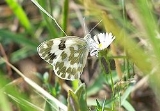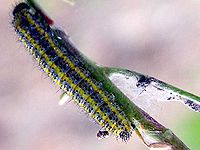
Bath White
Encyclopedia
The Bath White is a small butterfly
of the family Pieridae
, the Yellows and Whites, which occurs in the Palearctic
region. It is common in central and southern Europe
, migrating northwards every summer, often reaching southern Scandinavia
and sometimes southern England
.
 Description from Bingham, C. T (1907) The Fauna of British India, Including Ceylon and Burma. Butterflies Volume 2.
Description from Bingham, C. T (1907) The Fauna of British India, Including Ceylon and Burma. Butterflies Volume 2.
, Peshawar
, Chitral
, Kashmir
and along the Himalayas right across the Central Himalayas up to Darjeeling.
The butterfly appears to be extending its range westwards along the Himalayas.
Butterfly
A butterfly is a mainly day-flying insect of the order Lepidoptera, which includes the butterflies and moths. Like other holometabolous insects, the butterfly's life cycle consists of four parts: egg, larva, pupa and adult. Most species are diurnal. Butterflies have large, often brightly coloured...
of the family Pieridae
Pieridae
The Pieridae are a large family of butterflies with about 76 genera containing approximately 1,100 species, mostly from tropical Africa and Asia. Most pierid butterflies are white, yellow or orange in coloration, often with black spots...
, the Yellows and Whites, which occurs in the Palearctic
Palearctic
The Palearctic or Palaearctic is one of the eight ecozones dividing the Earth's surface.Physically, the Palearctic is the largest ecozone...
region. It is common in central and southern Europe
Europe
Europe is, by convention, one of the world's seven continents. Comprising the westernmost peninsula of Eurasia, Europe is generally 'divided' from Asia to its east by the watershed divides of the Ural and Caucasus Mountains, the Ural River, the Caspian and Black Seas, and the waterways connecting...
, migrating northwards every summer, often reaching southern Scandinavia
Scandinavia
Scandinavia is a cultural, historical and ethno-linguistic region in northern Europe that includes the three kingdoms of Denmark, Norway and Sweden, characterized by their common ethno-cultural heritage and language. Modern Norway and Sweden proper are situated on the Scandinavian Peninsula,...
and sometimes southern England
England
England is a country that is part of the United Kingdom. It shares land borders with Scotland to the north and Wales to the west; the Irish Sea is to the north west, the Celtic Sea to the south west, with the North Sea to the east and the English Channel to the south separating it from continental...
.
Description
- The Bath White is a small white butterfly with a wingspan of 45 to 50 mm. The underside of the hindwing has a pattern of greenish blotches, which is characteristic of the Bath Whites and easily identifies it from other pierids.
- Sexes can be differentiated by markings on the forewing. The male is differentiated from the female by the markings on the upperside of the forewing. The apex of the forewing is black with white spots and lines. There is a black spot at the end of the cell. In the case of the female, there is an additional discal spot in 1b. The female also has an obscure row of terminal and marginal spots on the upper hindwing.

- Male: Upperside: white. Forewing: basal half of costa narrowly irrorated with black scales, a broad irregular quadrate black spot over the discocellulars; apex and termen anteriorly, above vein 3 broadly black, with a subterminal series of spots of the ground colour, prolonged as fine lines to the terminal margin. Hindwing: uniform, the markings on the underside showing faintly through; a costal spot before the apex, and in some specimens, some obscure, anterior terminal markings indicated by irrorated black scaling. Underside: white. Forewing: the form of the markings as on the upperside but the base of the cell with an irroration of green scales, the black discocellular spot extended to the costa, often washed with green or with a green centre to the black; the apical patch green not black, with the spots of the ground-colour on it ill-defined and obscure; a black or greenish-black spot in the outer half of interspace 1. Hindwing: green; costal margin at base yellow; dorsal margin white; a spot in middle of cell, another above it in interspace 7, a curved irregular discal series of conjoined spots beyond the cell, of which the upper two spots in interspaces 1 to 6, white; the veins sometimes faintly yellow. Antennae dusky-black; head, thorax and abdomen fuscous black; beneath; head, thorax and abdomen white.
- Female: Upperside: differs as follows: Forewing: a dusky-black streak extends from the base along costa and terminates at the black spot on the discocellulars; a transverse, somewhat quadrate black spot in the outer half of interspace 1, with sometimes a short ill-defined black streak below it; the black area on apex and anterior portion of termen broader, the white spots on it blurred and obscure. Hindwing: a large costal black spot before apex; a broad, black, subterminal, inwardly diffuse, curved band in continuation of the same, and a terminal series of clavate black marks that start from the outer margin of the black subterminal band. Underside: markings much as in the male but broader. Antennae, head, thorax and abdomen as in the male.
- Expanse: 52-56 mm
- Habitat: Within our limits; the Western Himalayas; Chitral; Ladakh; Kashmir; Baluchistan. Spread throughout Europe, Asia Minor, Persia and Afghanistan.
Range
In South Asia, the Bath White ranges from BaluchistanBalochistan (region)
Balochistan or Baluchistan is an arid, mountainous region in the Iranian plateau in Southwest Asia; it includes part of southeastern Iran, western Pakistan, and southwestern Afghanistan. The area is named after the numerous Baloch tribes, Iranian peoples who moved into the area from the west...
, Peshawar
Peshawar
Peshawar is the capital of Khyber-Pakhtunkhwa and the administrative center and central economic hub for the Federally Administered Tribal Areas of Pakistan....
, Chitral
Chitral
Chitral or Chetrar , translated as field in the native language Khowar, is the capital of the Chitral District, situated on the western bank of the Kunar River , in Pakistan. The town is at the foot of Tirich Mir, the highest peak of the Hindu Kush, high...
, Kashmir
Kashmir
Kashmir is the northwestern region of the Indian subcontinent. Until the mid-19th century, the term Kashmir geographically denoted only the valley between the Great Himalayas and the Pir Panjal mountain range...
and along the Himalayas right across the Central Himalayas up to Darjeeling.
The butterfly appears to be extending its range westwards along the Himalayas.
Taxonomy and related species
- The subspecies in South Asia, P. daplidice moorei Röber 1907, is found in the higher hills of the Himalayas.
- Three other species of genus Pontia occur in India. They are the :-
- Lofty Bath Whites Pontia callidicePontia callidiceThe Lofty Bath White or Peak White is a small butterfly of the family Pieridae, that is, the Yellows and Whites, which occurs in the Palearctic zoogeographical region.- Description :...
(MooreFrederic MooreFrederic Moore FZS was a British entomologist. It has been said that Moore was born at 33 Bruton Street but may be incorrect given that this was the address of the menagerie and office of the Zoological Society of London from 1826 to 1836.Moore was appointed an assistant in the East India Company...
) 1865. - Lesser Bath White Pontia chloridicePontia chloridiceLesser Bath White , Pontia chloridice is a small butterfly of the Family Pieridae, that is, the Yellows and Whites, which is found in Asia. It is found in Chitral and Ladakh in Kashmir and Pakistan.-Description:Male upperside ground colour white...
HübnerJacob HübnerJacob Hübner was a German entomologist. He was the author of Sammlung Europäischer Schmetterlinge , a founding work of entomology.-Scientific career:...
1803/18. - Desert Bath White Pontia glauconome Klug (reported as a vagrant in the desert, plains and hills of northern India)
Habitat
In South Asia, the butterfly is known to be found in the Kashmir Valley and the plains of Peshawar in April.See also
- PieridaePieridaeThe Pieridae are a large family of butterflies with about 76 genera containing approximately 1,100 species, mostly from tropical Africa and Asia. Most pierid butterflies are white, yellow or orange in coloration, often with black spots...
- List of butterflies of India
- List of butterflies of India (Pieridae)

